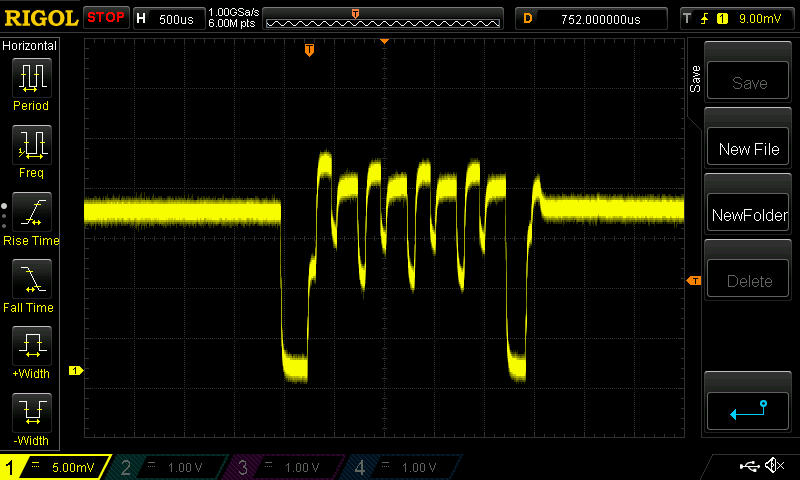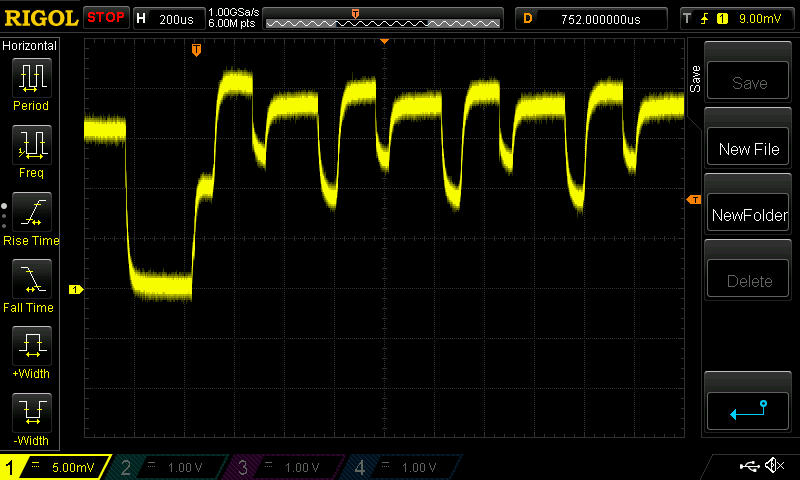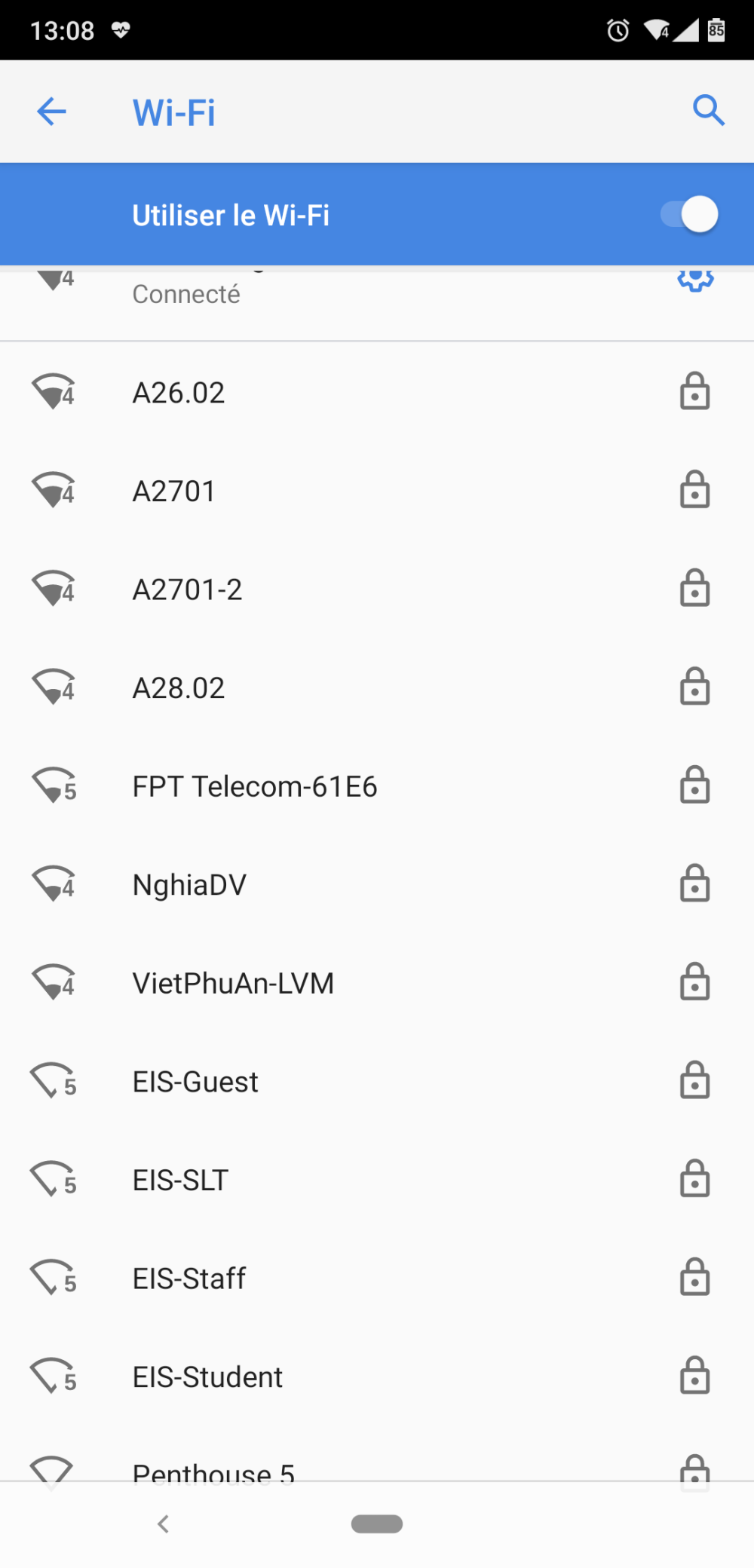Which are the *best* NRF24L01+ modules?
-
When I tested the iTead modules (see earlier posts in this thread), they proved out to be genuine. Since you're unequipped to make a determination yourself, then if you're just wanting a simple answer, I suggest you try those.
@NeverDie Hi there! So as a summary were you able to get a few trusted suppliers (sellers) to buy these modules from to get genuine ones?
Is this one a good one to buy from.
Aliexpres item -
@NeverDie Hi there! So as a summary were you able to get a few trusted suppliers (sellers) to buy these modules from to get genuine ones?
Is this one a good one to buy from.
Aliexpres item -
It turns out my scope can do better than I thought. Here's the blob module again, but this time at 5mv/div.


So, I may be able to use an even smaller resistor, because now I can go down to 1mv/div, whereas before it seemed it wouldn't let me go lower than 10mv/div. Hopefully that will help improve my measurement accuracy.
@NeverDie said in Which are the *best* NRF24L01+ modules?:
It turns out my scope can do better than I thought. Here's the blob module again, but this time at 5mv/div.

So, I may be able to use an even smaller resistor, because now I can go down to 1mv/div, whereas before it seemed it wouldn't let me go lower than 10mv/div. Hopefully that will help improve my measurement accuracy.Haha it seems back then you got cheated by the infamous zoom function of the Rigol oscilloscopes :D
-
@NeverDie said in Which are the *best* NRF24L01+ modules?:
It turns out my scope can do better than I thought. Here's the blob module again, but this time at 5mv/div.

So, I may be able to use an even smaller resistor, because now I can go down to 1mv/div, whereas before it seemed it wouldn't let me go lower than 10mv/div. Hopefully that will help improve my measurement accuracy.Haha it seems back then you got cheated by the infamous zoom function of the Rigol oscilloscopes :D
@Nca78 said in Which are the *best* NRF24L01+ modules?:
Haha it seems back then you got cheated by the infamous zoom function of the Rigol oscilloscopes
Haven't heard about that one. What makes it infamous?
-
@Nca78 said in Which are the *best* NRF24L01+ modules?:
Haha it seems back then you got cheated by the infamous zoom function of the Rigol oscilloscopes
Haven't heard about that one. What makes it infamous?
@NeverDie said in Which are the *best* NRF24L01+ modules?:
@Nca78 said in Which are the *best* NRF24L01+ modules?:
Haha it seems back then you got cheated by the infamous zoom function of the Rigol oscilloscopes
Haven't heard about that one. What makes it infamous?
Real resolution is 10mV/div, and from there it's only zooming from the 10mV/div data to reach the 1mV/div. They are "hiding" this, pretending to have better resolution instead of telling you it's zooming like other brands do.
-
Beginner here and I am gathering a list of parts to buy, the NRF24L01+ module is one of those. While browsing for buying advise I came across this, old but relevant, threads. Is there a list of verified vendors? As a beginner I want to minimise my variables early on so hope some one can help me. Couldn't find another thread that covers this question.
-
Beginner here and I am gathering a list of parts to buy, the NRF24L01+ module is one of those. While browsing for buying advise I came across this, old but relevant, threads. Is there a list of verified vendors? As a beginner I want to minimise my variables early on so hope some one can help me. Couldn't find another thread that covers this question.
I've tried a lot of the aliexpress modules.
My experience with cheap modules
- Cheap, generic SMD NRF24L01+ have always outperformed the non-smd cheap versions
- Avoid the cheap PA/LNA modules at all cost
- eByte, cdsenet, cojxu (all ebyte companies) have the best of the chinese modules. They are on sale often. I exclusively use their PA/LNA modules for gateways and repeaters.
-
From what I last heard, which was quite a while ago now, Itead is in the circle of trust.
The only way to know for sure though is to test the Tx and Rx current consumption using an oscilliscope and compare that against the datasheet specs on the radio that you paid for and that was (hopefully) delivered to you.
-
@ncollins is of good advice here. NRF24 are infamous for their bad range, but with good SMD modules (not the cheapest versions with a blob !) and a cdebyte pa+lna module (using external "stick" antenna) for the gateway I have a full reliable coverage in a 100m2 apartment. Despite being in a high rise with a lot of WiFi networks polluting the 2.4GHz band.

-
I've tried a lot of the aliexpress modules.
My experience with cheap modules
- Cheap, generic SMD NRF24L01+ have always outperformed the non-smd cheap versions
- Avoid the cheap PA/LNA modules at all cost
- eByte, cdsenet, cojxu (all ebyte companies) have the best of the chinese modules. They are on sale often. I exclusively use their PA/LNA modules for gateways and repeaters.
@ncollins Thanks for pointing that out. I hadn't noticed before that EBYTE had a super upgraded implementation for the nRF24L01 that includes a TCXO, 27dbm Tx power, forward error correction, and frequency hopping: https://www.aliexpress.com/item/32955792424.html?gps-id=7590465&scm=1007.14677.110221.0&scm_id=1007.14677.110221.0&scm-url=1007.14677.110221.0&pvid=404d40e9-e799-4d10-a4e1-d3ebe0d0df08&spm=a2g1y.promotion-20181111.promoteWysiwyg_502241756.1
The high sleep current would be a problem for battery operated nodes, but... seems interesting.At the very least it's an existence proof that we should be able to make the nRF24L01 do frequency hopping. A couple years ago on the lowpowerlab forum a number of us brainstormed how the RFM69 might be made to do frequency hopping, all through only atmega328p control (no extra hardware). IIRC, one guy went off and got it working. I presume the same general approach might be applicable to the nRF24L01 as well.
At the root of it all is the ability to keep all the clocks in sync--and recalibrating them as necessary--so that they are all hopping in unison from one radio frequency to the next.
https://www.youtube.com/watch?v=mC1bXugo78s -
Hi everyone, bumping this thread because I could read some of you were interested in packet loss (@NeverDie and someone else) and my findings could help fix it partially or completely via software.
It's certainly a hardware problem, though I can't figure out if it's due to the components physical positioning, the power supply, or both (and/or more issues like wiring, proper PCB traces, etc).
Also, even the same modules from the same manufacturer, say EByte E01 PA+LNA modules in my case, have shown different performances, so it might be something bound to the variability of the SMD components used as well.Let's get straight to the point.
I am the developer of rf24tunlink, a radio network bridge which uses primarily nRF24 modules.
During R&D, I found that around 30% of packets from my modules were dropped due to a couple corrupted bytes, which was constant even in close range. That does indicate a hardware problem already, but the distribution of the bit flips is an even stronger indicator.
All flips are in the first bytes!You might be getting at least one flip in most packets, resulting in ALL of them being dropped automatically because this invalidates the CRC. In this scenario ShockBurst can fail, or you might get duplicates, might not get ACK payloads or simply get a slow link because the same packet can be sent up to 15 times with a wait between each retry.
Not coming here unarmed: how to fix it?
Easy in principle, you:- Disable CRC -> ShockBurst off, no ACK payloads, essentially your module will be RX only.
- Implement RS ECC: sacrifice just enough bytes to fix all the corrupted bytes. (in my case, 2/32 was enough!)
That's how I turned a 30% packet loss into a 100% flawless reception, see this result:
There is more to it, as the link gets worse, of course this situation also gets worse. Finding out how many errors are in a packet can help you estimate signal quality and potentially take preventive measures.
Now, if you only care about sending a specific packet, you either receive it or not at all and that's it.
But if you want more like I did, then things get more complicated.In this case I wanted a full duplex link -> a second pair of nRF24 modules was mandatory
I also wanted to send network data (iperf, ping, ssh, realtime video, audio, telemetry, control, anything really) -> frames needed to be split into radio packets, sent, corrected and stitched back into a frame. That is a HARQ algorithm.After all of this, I could get a usable network speed of 1.2Mbps (determined via iperf). Used a Pi 4, Pi zero 2 W and 4 nRF24 PA+LNA modules.
You could use this same metric to evaluate your components, some modules could do better and some could do worse.Would be cool to fix this hardware for all and get closer to that 2Mbps max speed.
Some people declared a speed of 1.7Mbps and I have seen a 1.5Mbps peak during development, so there is definitely room for improvement.
